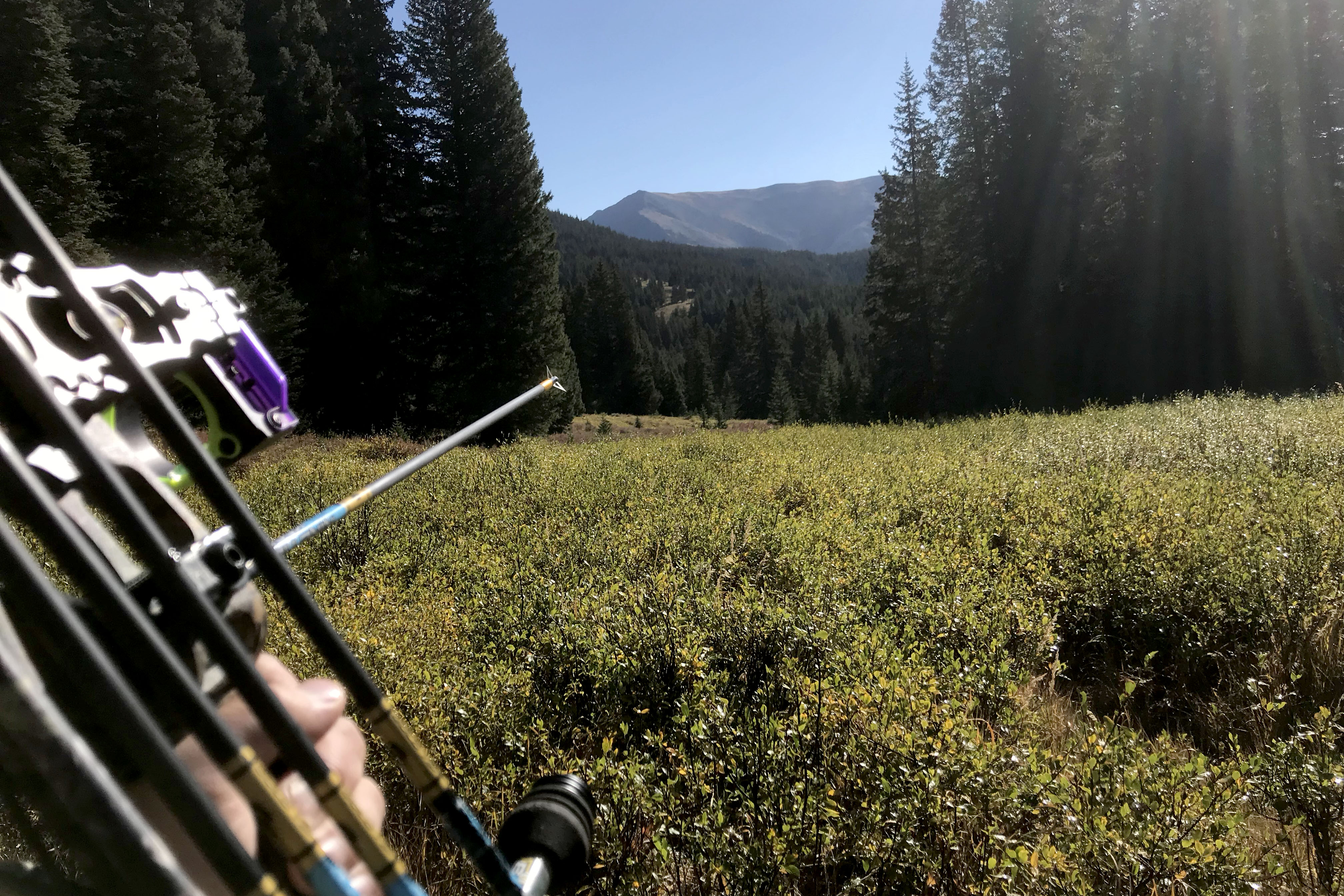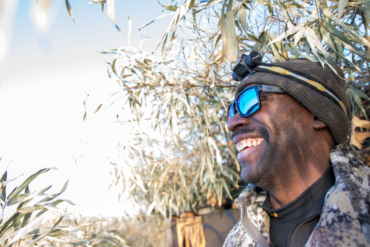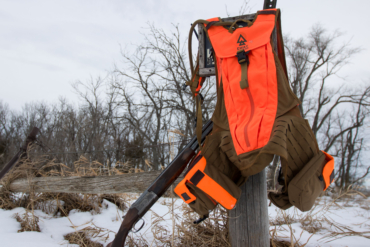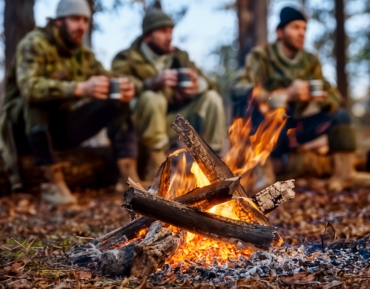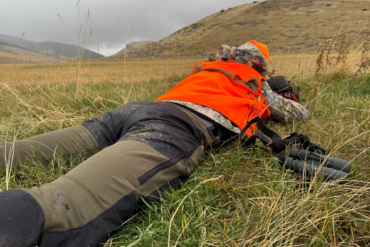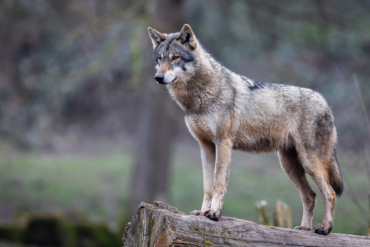Deer hunting is often an exercise in patience. And with time comes an opportunity for reflection.
Sunlight glinted off frosty grass. My pants swished quietly through knee-high brush as I walked. It had been a quiet morning of hunting, and I moved to find animals high in the Rocky Mountains.
The L-shaped meadow stretched for about 300 yards. Pine trees fringed the meadow on small ridges. They cast long shadows onto the red-gold leaves that filled the meadow. It had been a frustrating couple of days. With no bugling and little sign, my friends and I struggled to find elk and deer.
Big-mountain hunting with a bow is hard. I grew up in Wisconsin, where the rhythms of fall beat around archery and rifle deer seasons. I was 14 years old when I learned to love 4 a.m. coffee before hours in a deer stand.
Then, more often than not, we’d spend a Sunday afternoon listening to the Packers while my dad taught me to skin a doe and get it ready for the freezer. We’d put the tenderloins in a skillet and eat them first, fresh off the day’s kill.
But in Colorado, I consistently ate my tag during the archery season. Nearly a decade of hard work put nothing in my freezer. Sure, there were close calls, but I had yet to connect on so much as one deer. So, this morning, I walked with purpose, and I was ready to cover some ground.
As I reached the bend in the field, a shape caught my eye. Nearly obscured in the grass and brush, a set of tall antlers stood out, motionless. A mule deer sat bedded in the grass, looking straight at me. I froze. He was 200 or more yards away.
I know the reality of meat. I’d shaken like an aspen leaf when I’d drawn my bow as an adolescent and taken my first deer. I still remember sitting in a homemade deer stand 12 feet above a forest floor thick with pine needles. My heart began to beat out of my chest when I saw that little nubbin’ buck in bow range.
A half-hour later, when I laid my hands on the dead animal’s body, I confronted unexpected emotions. They’ve only grown more complicated as I’ve gotten older.
In modern times, stories like this are less common than ever. While the vast majority of people in the United States still eat meat, we could not be less connected to it and the circle of life it represents. Just 11 million people hunted in 2016, down more than 2 million from 2011. More than 327 million people live in the country. That’s a lot of people who will never look their dinner in the eye.
I slowly took a step back behind a small pine tree alone in the meadow and pulled out my rangefinder to look more closely. I wasn’t sure if he’d seen or heard me, but either way, the deer quickly lost interest.
His antlers moved slowly as he scanned other hillsides and relaxed in the morning sun. I had an opportunity. But as a predator with years of experience and many recent failures, I knew it was not an easy one. I backed out of the meadow.
The mule deer evolved with acute senses of hearing and smell. They spend their lives avoiding predators. And judging from his antlers, this buck was at least a few years old. He’d weathered cold, snowy winters.
He’d witnessed spring bring its torrents of meltwater. And he’d certainly crossed paths with his fair share of humans up here in this popular playground of Summit County, Colorado. Some of them had likely been hunters.
Puzzling over the deer’s lack of action, I decided to try and get closer. I snuck into the shadows at the edge of the meadow, my approach blocked by trees. I used a range finder to measure the distance to the other side of the meadow. 150 yards. I figured the deer was 120 yards away.
I edged along the meadow toward the deer. The ground was dry and crunched under each step. I winced as I snapped twigs. How would I possibly sneak up on this highly evolved prey animal?
This deer spent every day in these meadows and forests where I was but a visitor. He knew the taste and smell of each stream. He knew where the grass was fresh. And he knew where danger lurked.
It would be an unlikely gamble for me to pursue him. I decided to roll the dice.
The previous night we’d had deer for dinner at my parents’ home in the Colorado mountains. My mom cooked up a big pot of chili with ground venison from my friend’s kill earlier in the season. I’d been there to help him gut it out and clean it. We’d taken it home, and hung it up the garage. There, we skinned it and portioned off large red slabs of meat. Those all got cut up into smaller portions, and they were wrapped before going into the freezer.
We sat around the kitchen table eating the venison and some bread and drinking wine. We talked about my friend’s toddler-aged kids. It was a joyous feast and a great precursor to another day hunting.
The antlers moved toward the edge of the meadow. “Busted,” I thought. In my mind, I decided that the deer finally heard me and slipped away. My mind placed it walking up through the dark timber on the facing hillside. I figured I’d never see him again.
For the first time in a half-hour, I stood upright fully and let myself breathe naturally. It’s amazing how draining it is to focus on being silent, minute after excruciating minute. I felt the blood flow through my arms and legs. Time to get back to covering some ground. I was looking for an elk herd primarily, so I needed to get back to business.
With another glance toward where I’d seen the buck, I saw nothing. No antlers. No deer. Just waist-high bushes in the morning sun.
Intent on the opposite ridge, I aimed across the meadow and walked naturally. My human movement revealed a “crunch, crunch, crunch” to anything in earshot. I didn’t care. I needed to get into the woods and up on the ridge. So I thrashed through the surprisingly tall bushes for 75 yards, crossing close to the spot I’d seen the buck. Nobody home.
Finally in the shade of trees again, I climbed the opposing ridge. I knew an elk herd had been using the dark timber of the ridge recently and wanted to find them. I slowed my pace to a crawl as I climbed above the meadow. Up the ridge I climbed, 25, 30 yards. It was a calm morning, and the wind blew softly in my face, back toward the meadow. Perfect stalking weather.
I turned my eyes back over my track and my heart leaped in my chest. There, barely off my tracks across the meadow, sat a giant set of antlers, still arcing toward the azure sky. The deer was still bedded. I’d walked within 20 feet of him as he lolled in the sun, hidden by bushes.
I slowly turned back toward the meadow. I could see the deer looking straight at me, just antlers and eyes. Branches and leaves hid its body from sight. I pulled the rangefinder from my pocket and moved it slowly to my eye. The deer was just 70 yards away. Close, but still too far for a shot, and his body — my only possible target as a bowhunter — was hidden by brush.
Well, he has to see me, I thought. I might as well see if I can get closer. Maybe he’ll stand and give me a shot. So I crept carefully down toward the edge of the meadow. Trees on both sides of me cast dark shadows. The earth here was moist and I made barely a sound.
The deer didn’t move as I closed the distance. Sixty yards now. Then, 10 minutes later, I was at the very edge of the meadow. “What luck!” He still hadn’t moved but kept his eyes trained my way. I was in range now but had no shot at the bedded deer. All I could see was antlers, slightly below me, in tall grass and brush.
I ranged the deer again. 52 yards. With no possible shot, there was nothing to do but wait. I cautiously replaced the rangefinder in my pocket. How was this deer still here? The very fact that it hadn’t already bolted into the distance puzzled me.
I’d walked close to it across an open meadow. I’d snuck down a ridge to get within a comfortable shooting range. And yet, it sat stock still in the wide-open meadow. I wondered if I was seeing things.
Then the antlers moved. Slowly, they tilted to the front, bobbing gently. His ears flicked quickly.
My heart raced. This was a big buck. A good shot would mean a lot of meat for the freezer this winter. Many meals of steak and chili and stew. My palms were sweaty, and I noticed myself shaking slightly. I needed to calm down.
A mosquito bit my ear. I winced a little, not wanting to move to brush it away.
Guess the bugs are getting to you, too, I thought, watching the flicking ears. I wonder how you deal with them all summer.
I thought about the time. I’d left camp around 8 a.m. What time was it now? My wife was planning to join me in the afternoon, and I needed to coordinate a rendezvous point.
I didn’t dare lift my arm to look at my watch. I kept my eyes focused on the deer, expecting him to leap to his feet at any second. By now, I’d decided that my only chance would be to wait for the deer to stand up. Then, hopefully, I’d be able to get a shot at its vitals: the heart and lungs.
I had no idea if he would be facing me when it stood — a risky shot that I would not consider taking at this range — or broadside. My only chance at putting meat in the freezer was a broadside shot. Fifty-two yards was the edge of my comfortable shooting distance. The shot would have to be perfect, or else this effort would be fruitless.
It was the only hand I had. I decided to play it.
I kept my eyes on the antlers. They rarely moved. When they did, they swayed in one direction or another. I assumed the deer was scanning its home for possible danger.
How long do deer nap? I noticed my feet started to fall asleep. I’d been standing for 15 minutes or so in one spot, not moving a muscle. My excitement started to pass, and my heartbeat returned to normal. And I realized I had no idea how long a deer normally stays in a bed in the morning.
Where I stood on the hillside was a slight down-grade. My toes were about 4 inches below my heels. It wasn’t exactly comfortable. I had to stay still. But I also had to be able to draw my bow and shoot accurately. I risked a little motion and lifted one leg a couple of inches and spun my foot in circles.
Then I did the same with the other foot. The relief was excellent. The deer didn’t move. I wanted to stretch more, but I couldn’t risk much motion.
Yesterday I’d messed up. The memory was fresh. Sneaking through a forest, I’d seen a nice buck through the trees 40 yards away. It noticed me. But I was impatient and drew my bow. I held it for minutes, shaking as the deer stared at me. I lowered my bow, shaking, to watch the deer bound across an opening 10 yards farther along the trail. I’d been hasty and I’d blown a good opportunity. Be patient.
My cellphone vibrated in my pocket, a reminder that the rest of the world went on, uncaring of the small but mortally important game playing out in a small meadow in the Colorado mountains.
Was it my wife? One of my hunting party texting to meet up at the truck or report a kill?
I didn’t dare reach for my pocket to find out. The deer still lay in the field. A flurry of texts followed. Buzz, buzz, buzz. My phone kept alerting me of something going on elsewhere.
I maintained my focus and resisted the urge to look at the phone. The buzzing continued for several minutes. Plus, my feet hurt. And my ankles and legs.
What had it been? An hour, stock still? Should I risk making a noise to get the deer to stand? It seemed risky. Buzzzz! Fine, I thought. Just a quick peek.
Cautiously, I put my hand in my pocket and slowly pulled out my phone. I raised it slowly to illuminate the screen and saw the notifications. A couple of buddies chatting. A work question. Nothing of importance. I noted the time: 9:45 a.m. I’d been standing here for an hour and 15 minutes.
I slipped the phone back into my pocket and kept my eyes on the deer. Its head bobbed slowly in the meadow as he dozed in the morning sun.
My phone buzzed more. I didn’t care. Back to waiting. Minute by minute, I contemplated what to do next. Make a noise? A grunt? Or wait out the deer. It had to stand eventually.
I visualized my shot over and over. The deer would stand. Would I get a warning? I would raise my bow smoothly and draw. Avoid the tree branches to my right. Find the green 50-yard pin. Put it on the heart, steady, shoot. I’d done it a thousand times on targets.
But this shot would either wound or quickly kill a beautiful creature that I did not want to suffer. He’d done nothing to harm me. But under that fur and set of antlers rested dozens of meals for my family.
To collect them meant taking a life, one that — at this moment — looked pretty pleasant.
I wondered how he spent his summer. The meadows unfolded above my perch in a cascade of flowers and trees. Birds chirped near and far. Squirrels dropped pine cones in thumps from the dark glades. And I hid, a predator waiting his chance to strike. I felt connected to ancestors going back through the millennia.
How many times had this played out in this very spot over thousands of years? My shot had to be perfect.
The deer’s antlers bobbed low above the grass. I figured he was grooming itself, probably licking his fur. Maybe chewing some grass and flicking away insects.
I lost track of time. I thought about soldiers at attention. Didn’t they sometimes fall over, passing out from lack of blood flow? I’d been here for at least 2 hours, not moving. I focused on pulsing my muscles to keep the blood moving. I felt dizzy from time to time. My throat was dry. I fought off coughs. I held back sneezes.
And then, as casually as a cloudy sunrise, the deer stood, stretched, and stopped. Broadside. At 52 yards.
Muscle memory and practice took over. Just as visualized, I lifted my bow slowly and pulled on my release. The 65 pounds of resistance rocked back with my cams, and I found the 50-yard sight in my peep.
I felt nearly disembodied as the point fell just behind the deer’s front shoulder blade on his chest. I don’t remember touching the release, but the arrow suddenly rocketed forward with nothing more than a nearly silent whistle. Half a second passed, then …
Crack! The arrow impacted the deer. The shot looked good, but at that distance, it’s hard to know for sure.
The deer trotted forward, surprised by the noise and impact and pain. He moved across the meadow, and I saw the arrow flip into the air. Did it hit a bone and not penetrate? Did it punch all the way through?
The deer reached the edge of the meadow. He wobbled as he turned into the dark timber. I thought I saw red blood streaming from his chest. “Good shot,” I hoped in my mind.
I watched him go as far as I could. Then, he disappeared, blocked by trees. It was quiet save the wind, squirrels, and birds.
I found the deer an hour later. He was lying dead with a hole in his heart about 100 yards from his bed. The trail was very short, and he’d died almost instantly. Relief flooded my body.
I took a moment when I saw him, unmoving, a pile of fresh venison on the forest floor. Having watched this big buck for hours, I imagined he’d seen things I’d never understand: winter storms so fierce that I would wither in their winds, nights so clear that the forest floors illuminated with starlight, meadows so warm and sunny that even the scent of a human wouldn’t lift him from slumber.
He made a mistake that cost him his life. I played my cards right, and now his life would flow into mine. His life was lived free. His death was quick and in his home. It was better than a feedlot and a cold metal cage of industrial farms.
I knelt and touched his antlers, the first human contact on this wild animal.
“Thank you,” I said out loud.
Then I reached into my pack and pulled out a knife. It was time to get to work.
